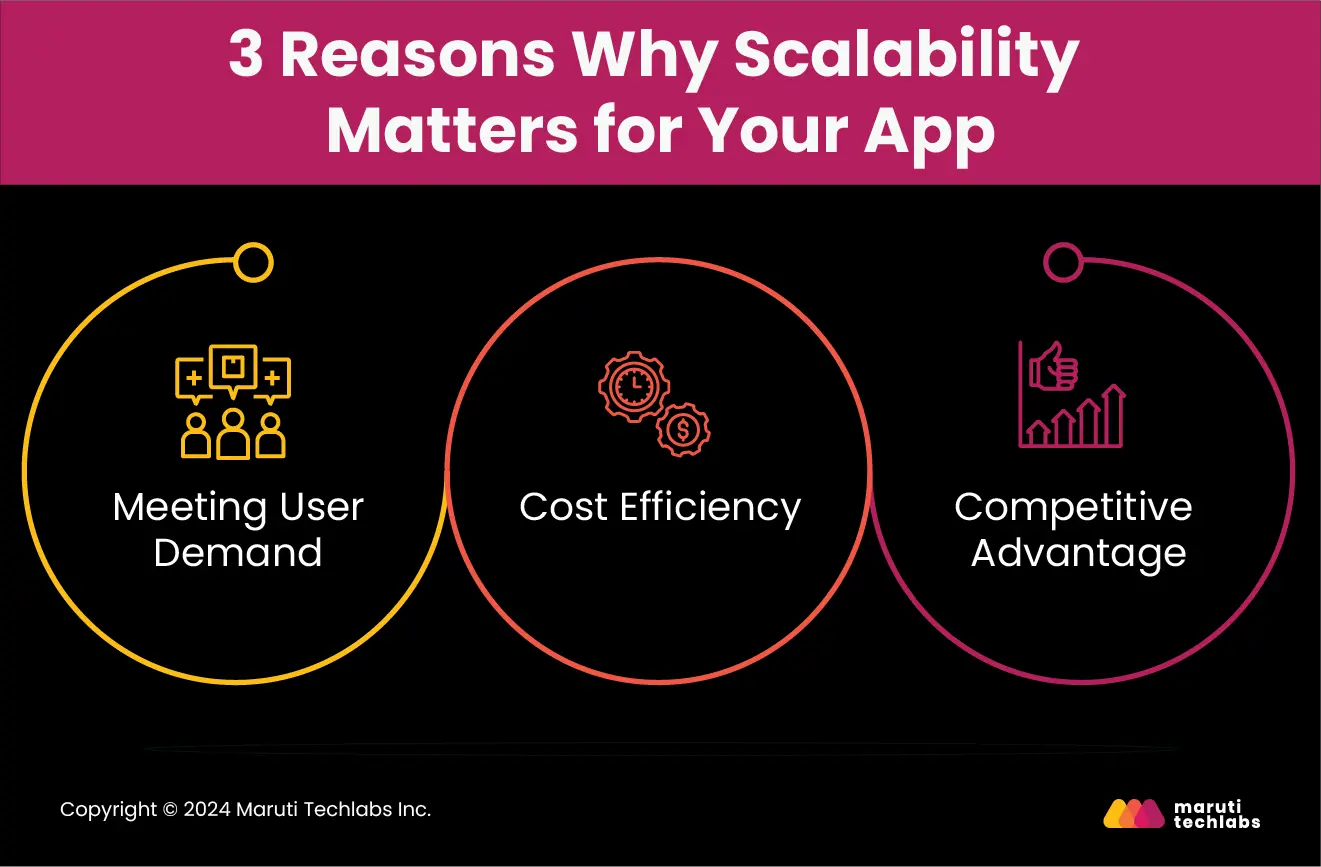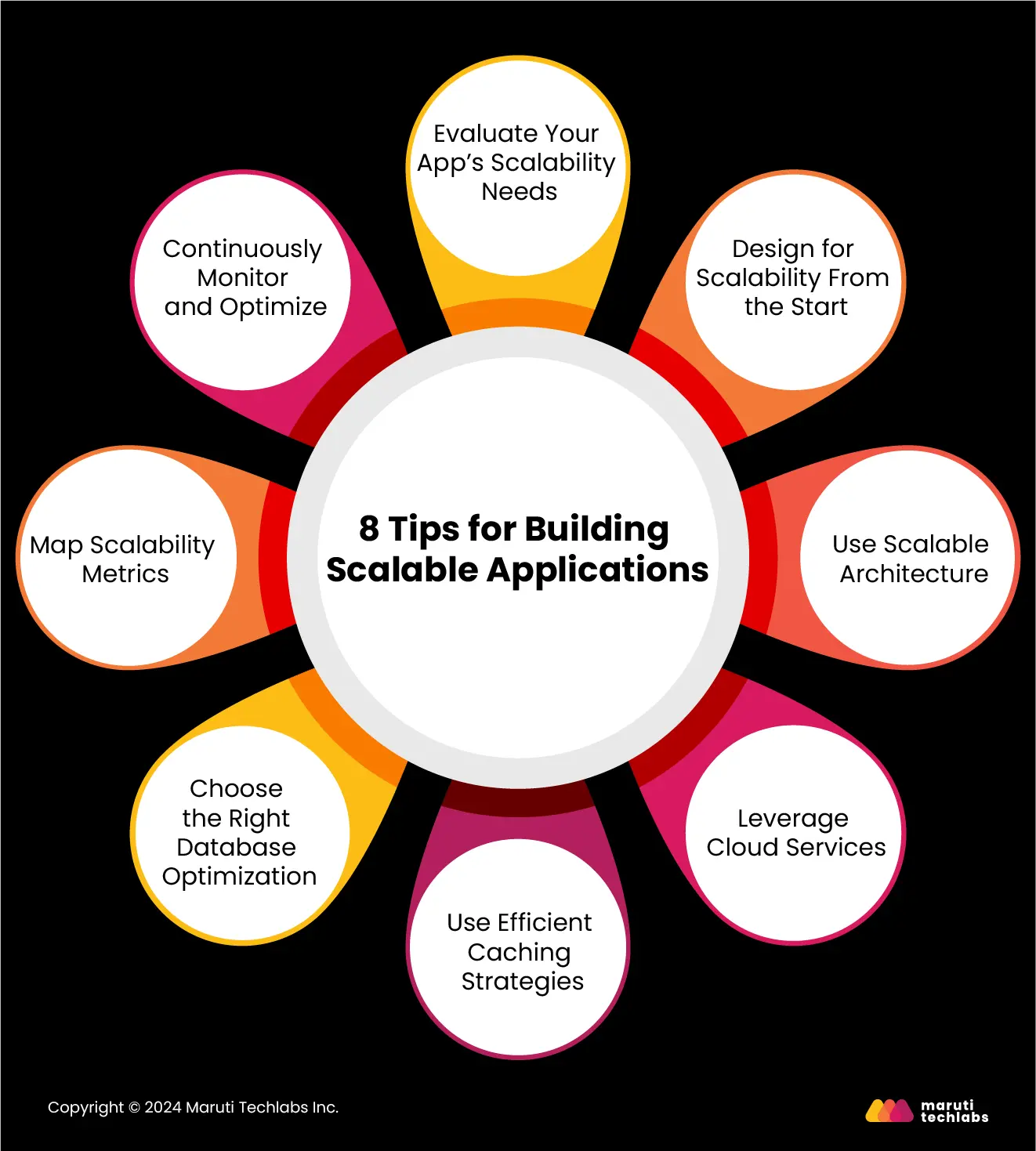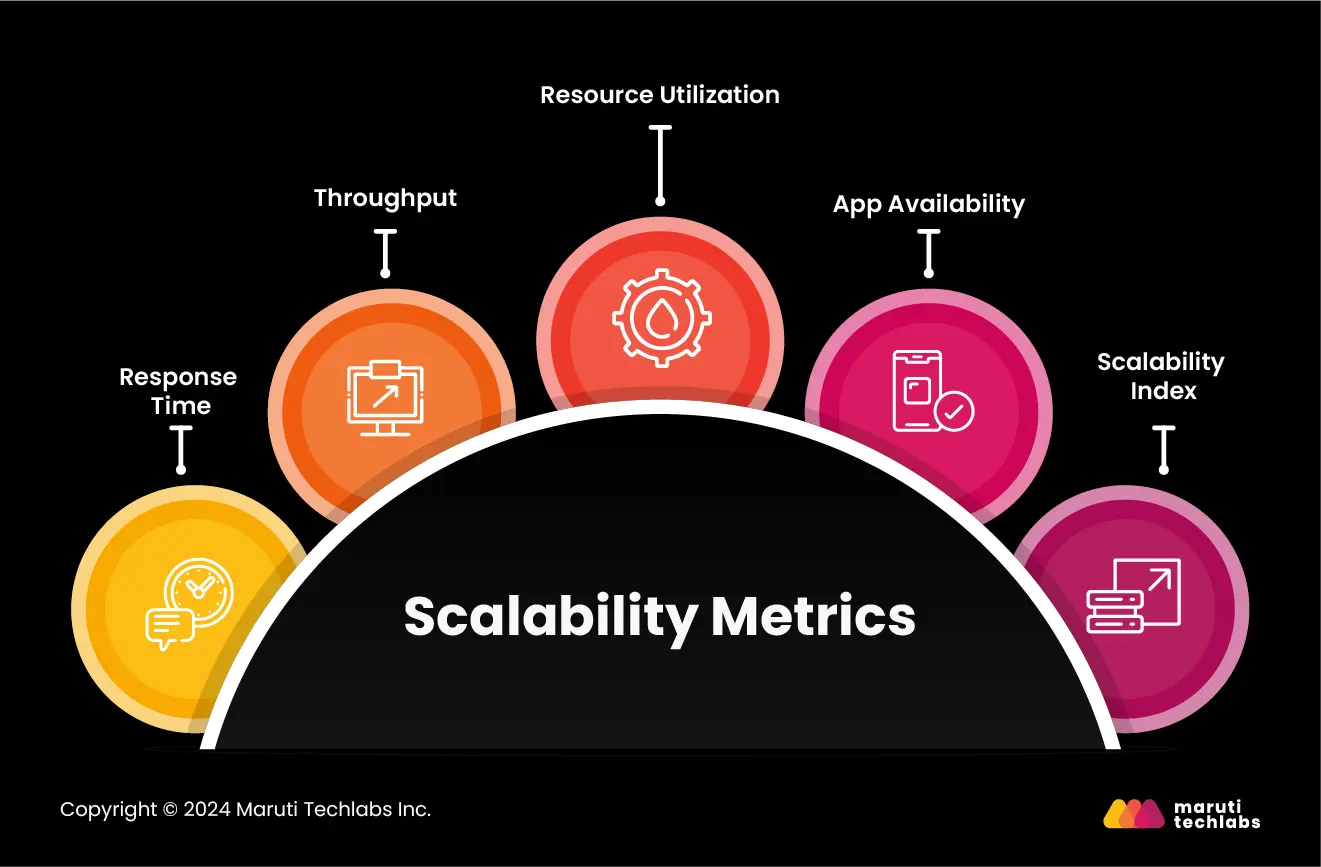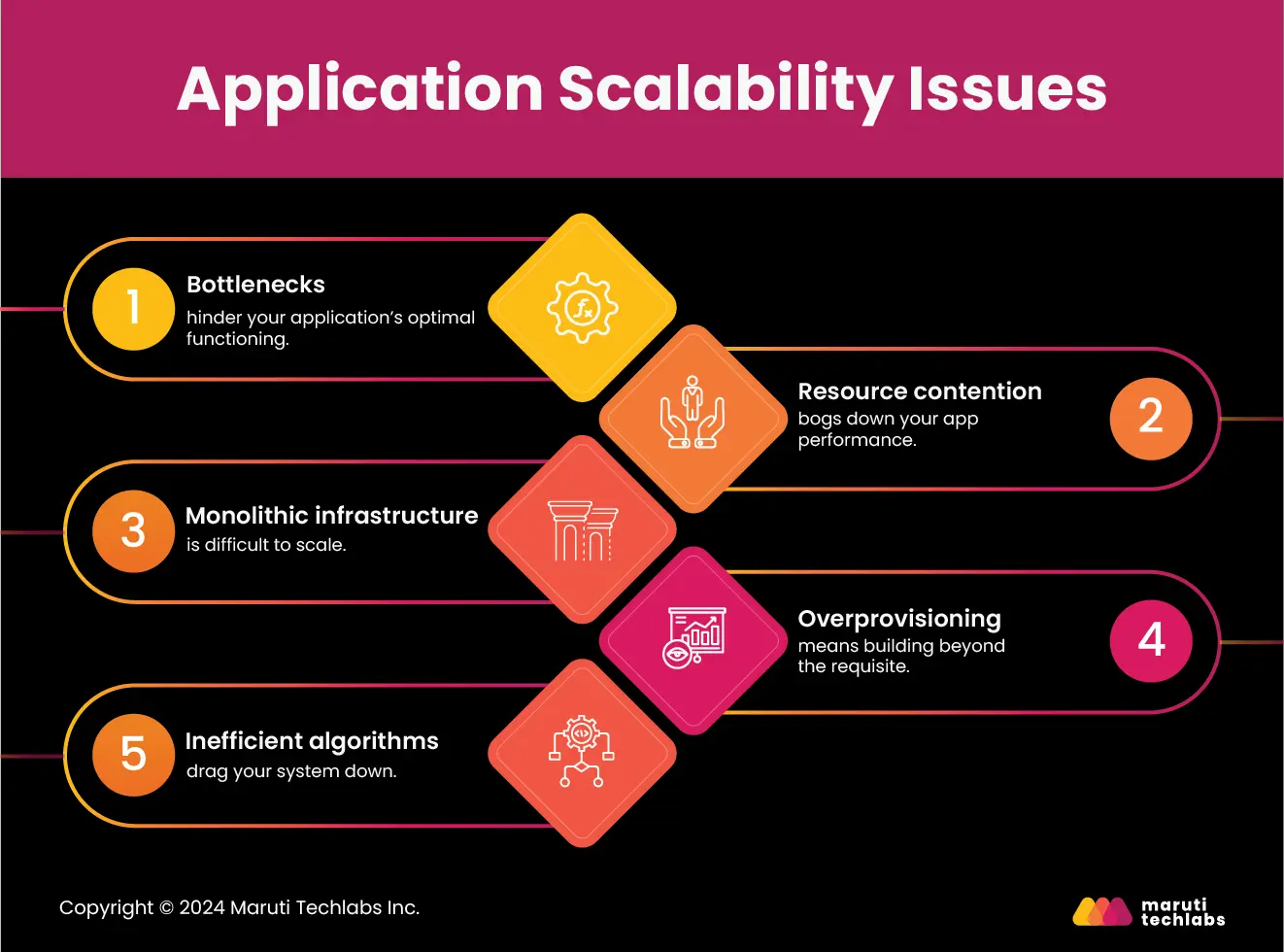

Future-Proof Your App: Scalability Considerations for Long-Term Success






Whether you plan to launch a new app or envision exponential growth in your existing app, you must know ‘scaling apps’!
Imagine your product becoming the next big thing, like Candy Crush Saga, Pokemon Go, Instagram, or Snapchat, with millions of downloads every minute.
How smoothly will your app handle this increased load? Will it be a seamless journey like Netflix’s, or are you up for a frustrating user journey with poor performance or app unreliability?
Scalability is the key to sustainable business growth. It's not merely a topic for future deliberations when success knocks—it's the bedrock that determines your application's destiny.
Candy Crush Saga experienced a 12-fold increase in revenue in just a year. But what’s more impressive is that they accommodated this growth with only a six-fold cost increase, sketching a nearly 70-fold increase in operating income.
This is the power scalability holds!
This blog covers everything from the minute details of scaling apps to challenges you can anticipate while scaling your app.
Scalability is the flexibility of an application.
It is essential to adapt to varying demand levels. Your application must deliver top-class performance consistently regardless of the number of users without compromising speed, functionality, or reliability.
Scaling apps can be of two types – horizontal scalability and vertical scalability.
Tech giants like Google, Facebook, Amazon, and Zoom employ horizontal scaling. While horizontal scaling is expensive, complex, and requires maintenance, it ensures less downtime and better flexibility. ERP software like SAP ERP or Microsoft Dynamics can benefit from vertical scaling.
Scalability metrics are performance metrics used to measure your application's scalability. Standard metrics include response time, throughput, resource utilization, and error rate.
Let us discuss these metrics in brief:
If you want millions of happy users, scaling the app is your key!
Unfortunately, several businesses were blindsided by last-minute scalability issues.
Pokémon GO experienced the heat of poor scalability when it became an overnight sensation. The game's servers could not handle overload, which led to frequent crashes and downtime. Similarly, Twitter crashed when millions of users started conversing on the app!
Thankfully, some apps wrote their success stories on scalability.
The best example of a scalable app is Zoom. Zoom's user base skyrocketed from 10 million to 200 million during the lockdown. Offices were migrating to virtual meeting rooms, and Zoom seamlessly facilitated this with disruption-free services.
Zoom’s ability to scale quickly took it from $623 million to $4.10 billion in just two years.
Here are three reasons why scalability matters for your app:

Scalability enables you to build and integrate new and exciting features into your app. It makes your app react quickly, adapt to changing user requirements, and attract more users without compromising performance. Check out Netflix. The application easily accommodates its growing user base, releases new features frequently, and delivers a flawless user experience.
Scalability means accommodating growth without increasing your infrastructural resources. Auto-scaling empowers applications to scale up when the load increases, and resources can be scaled back down once the traffic subsides without a substantial change in cost. The Black Friday Rush is an excellent example of how autoscaling helps e-commerce sites.
Scalable apps enable organizations of all sizes to quickly adapt to changing market dynamics. Whether you're a start-up or a legacy enterprise, scalability allows you to meet evolving customer needs, thereby gaining customer loyalty and trust.
Now that you know why scaling apps is so important, let’s understand how to build scalable apps.
Any application, no matter how big or small, must be designed and developed with scalability in mind.
Here are 8 tips for building scalable applications:

Not all apps are meant to scale.
Although it is recommended to factor in scalability while designing an application, one needs to know that not every application requires the feature.
For instance, the use of a calendar, calculator, or notes on the phone does not require a firm scalability plan.
Therefore, the first and the most crucial is to determine whether your application requires scalability at all.
Some areas to consider include expected user growth, occasions of peak usage, and downtimes. Understanding your requirements better will enable you to make informed decisions.
Scalability isn't an afterthought!
You do not bring it to the table when the traffic explodes and your application goes gaga. That would mean colossal downtime and lots of disappointed users!
During your application's very early planning phases, you must be clear about its scalability requirements. You will choose your architecture, infrastructure, and tech stack depending on these requirements.
A scalable architecture forms the foundation of scaling apps.
For example, choosing an architecture supporting loose coupling lets you quickly amend or launch new features. Modularity in your architecture isolates different components, permitting you to scale each component independently.
Proven architectural patterns like microservices, containerization, serverless computing, or event-driven architecture can facilitate seamless app scaling. A survey by Camunda revealed that about 63% of organizations adopt a microservices architecture.
The microservices architecture creates a decentralized environment, enabling development teams to independently isolate, rebuild, reimplement, and manage services.
Scaling your application has become easier than ever with cloud computing!
Netflix initiated the concept of scalability with the help of the AWS cloud platform strategy. Using AWS, you have unlimited access to resources; applications can increase or decrease their resources where necessary.
For example, if there is a higher demand for application usage, AWS can auto-scaling the resources needed to accommodate the demand. This dynamic scalability ensures flawless app performance even at peak traffic.
Caching improves your app's speed and user experience.
Caching is a technique that enables users to access information quickly. It removes the burden from your servers by placing relevant information into memory, resulting in reduced latency and improved speed and performance.
Cache servers such as Redis or Memcached keep frequently accessed data in memory. There are several caching types, including page, object, and database. One can choose an appropriate caching strategy based on the app's scalability needs.
Database scalability is the heartbeat of an application.
But what does it mean for the databases to be scalable?
Scalable databases refer to systems that can efficiently handle increased data volume, user traffic, and processing demands by expanding resources or distributing workload across multiple servers without sacrificing performance or reliability.
Database scalability refers to the ability of an application’s database to expand in a controlled manner so that it can successfully handle a greater number of users and or transactions. Normalization, indexing, partitioning, and caching are some strategies that can be used to enhance database operations.
Scalability metrics are indicators that help you assess the effectiveness of your application.

Key metrics include response time, throughputs, resource usage, fault tolerance, and horizontal and vertical scalabilities. Using these metrics, you determine the performance baseline and the areas that may require improvement once the application has grown.
By adopting this proactive strategy, you can uphold peak performance, avoid congestion, and manage expenses efficiently, improving user satisfaction and facilitating your application's expansion.
Achieving peak performance is more than establishing a robust IT infrastructure. It needs ongoing attention, continuous scalability testing, and management.
You can rely on advanced tracking tools like AppDynamics, Scout, or Dynatrace to monitor scalability effectively. These apps help you track critical metrics like CPU, memory usage, and network bandwidth.
In today's era of rapid evolution, even the giants encounter challenges in scaling up. Whether it's Twitter facing an outage or Netflix going down for three straight days, scalability has always been a concern for tech giants.
So, taking a note from history, here are a few scalability issues that you must be aware of:

Bottlenecks are situations where your app’s performance or data flow is restricted. It’s like traffic getting restricted when vehicles move from a larger highway to a narrow road.
Bottlenecks hinder your application’s optimal functioning!
Bottlenecks can stem from various sources in scaling apps. They may be caused by constraints related to hardware limitations, inefficient algorithms and data structures, poor database performance, or network issues.
Inadequate resource provisioning or poor load balancing can also lead to performance bottlenecks.
Resource contention bogs down your app performance.
Resource contention occurs when an inadequate infrastructure or a scarcity of resources is involved. In such situations, multiple processes compete for resources.
Leveraging cloud services is one of the best ways to overcome resource contention. Many successful apps rely on AWS scalability for allocating and managing resources.
Monolithic infrastructure is difficult to scale.
In a monolithic infrastructure, all the components are tightly coupled, making it hard to isolate and scale individual components. This impedes new feature addition bottleneck identification and results in slow response times.
Moving to microservices or containerization is an intelligent choice for scalability.
Overprovisioning means building beyond the requisite.
For example, if your app currently has 10 active users but you are investing in infrastructure to support 10 million users, this is termed overprovisioning.
Overprovisioning is a safe bet in a world where bigger is better. However, allocating excessive resources—servers, storage, or network bandwidth—can lead to wasted resources and increased costs.
It results in underutilized resources and inefficiencies. Leveraging modern tools like predictive analytics to anticipate your load can help eliminate overprovisioning.
Algorithms are the brain of your application.
A well-structured algorithm produces a simple, correct, fast, and easy-to-maintain program. An ineffective algorithm decreases the system’s efficiency, malfunctions in an application, and impairs its ability to expand.
Analyze your app algorithm for speed, memory usage, and other quality factors to ensure optimal performance. Use profiling tools to understand your code’s resource utilization, conduct code reviews, and real-time testing to evaluate your algorithm.
Scalability is the key to creating applications that stand the test of time.
The trajectory of popular platforms like Friendster, Myspace, or Orkut highlights the importance of mobile app scalability in sustaining user satisfaction and relevance over time.
In today's dynamic times, a successful app should be able to scale from 100 users to 10 million users. However, merely acknowledging the importance of scalability is not enough; it's about using the right strategy from the beginning.
Being scalable doesn't mean having massive infrastructure at your disposal. It means choosing the right architecture and tech stack, leveraging cloud computing, optimizing databases, using caching strategies, and evaluating scalability metrics.
Implementing scalability requires foresight, flexibility, and continuous refinement. At Maruti Techlabs, we specialize in cloud infrastructure management services and craft tailored, scalable web apps. As a leading provider of web development New York, we combine vertical and horizontal scaling expertise to ensure exceptional performance, reliability, and cost efficiency.
Partner with us to overcome scalability challenges and maximize your digital presence's potential.
Scalability refers to the database's ability to cope with an increase in the scale of the data, transactions, or users. This means that as the demands on the database increase, the database can grow (it can increase the capacity of a single server) or expand (it can spread the workload over several servers) without affecting compatibility, quality, or availability.
Estimating scalability in mobile app development involves evaluating several factors:
It's the ability to handle growing amounts of data efficiently. This includes the method’s capacity to process large datasets without significant performance degradation, manage more complex and diverse data as it grows, and utilize computational resources effectively, including CPU, memory, and storage.
In a business context, scalability refers to a company's ability to grow and manage increased demand without compromising performance or losing revenue. This involves maintaining or improving operational efficiency as the company expands, effectively managing increased resources such as staff, inventory, and capital, and having the capacity to enter new markets and regions successfully.
Cloud computing increases the efficiency of data warehouses in terms of scalability. Instead of investing in new hardware resources, a data warehouse can quickly scale up or down depending on the current demand. Cloud platforms ensure that data warehouses can process large volumes of data using distributed computing techniques on multiple nodes.
Cloud computing scalability is the capability to support the increasing need for resources based on an application’s workload. This refers to elasticity, where resources are adjusted automatically according to demand. Horizontal scaling increases the number of service instances, while vertical scaling increases an instance's capacity.


